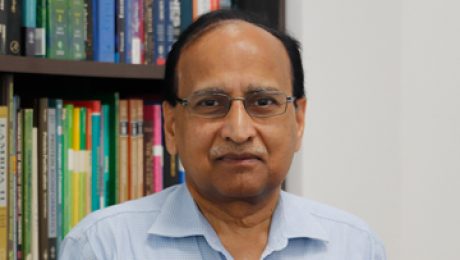Department of Scientific and Industrial Research (DSIR) registers SRM University, Andhra Pradesh, as a Public Funded Research University
Becomes first ever University to receive this stature in just two years of business operations
25th July 2019: The Department of Scientific and Industrial Research (DSIR), Ministry of Science and Technology, Government of India has considered SRM University, Andhra Pradesh under Public Funded Research Institutions / Universities and granted a Certificate of Registration dated 5th July 2019. This prestigious certification entails exemptions in customs duty while importing research equipment as well as in GST when procuring materials from within the country. SRM University, Andhra Pradesh is now eligible to pay only 9% on customs duty and 5% GST on national equipment as against the stipulated 30-40% and 18% respectively.
- Published in News
7th August 2019: University Research Council is meeting at SRM AP Amaravati – Wednesday, August 7th 2019
The Research Council will provide the future directions for the research to be carried out by the faculty members & research scholars of SRM at Amaravati. University Research Council will be chaired by Dr. V.K. Saraswat, Hon’ble Member, NITI-AAYOG.
- Published in Uncategorized
10th and 11th August 2019: SRM AP Amaravati to host STEP (Society for Training and Employment Promotion) and Girls in Tech mentorship program
- Published in Uncategorized
Active Learning at SRM Amaravati- The present and future of higher education
Active Learning at SRM Amaravati- The present and future of higher education
The growing presence of the Millennials followed by Gen Z has changed the nature of the workforce world over. Their expectations from the workspace are dynamically different from their predecessors. Interestingly, expectations of corporates and the industry have changed too. Problem-solving, decision making, EQ are some of the most sought-after skills now.
Centres for higher learning and educationists have had to rise to the challenge to shape professionals who possess these skills. It has prompted them to adopt new-age learning strategies that lead to the desired growth and development of students. Amongst the strategies, Active Learning is one that has shown exciting results and is definitely here to stay.
What is Active Learning, and what makes it different?
Quite simply, it is an approach to teaching where students are active participants in the learning process. It’s in stark contrast to conventional lecturing where, as a student, you would be a passive recipient of knowledge. Active Learning approach can be implemented in different streams of education equally effectively.
In traditional classrooms, you would have only a few students asking or responding to questions every session. Active Learning changes that as it not only allows but also enables all students to participate in learning activities. However, that does not mean it has to replace the traditional classroom format completely; in fact, it serves as a powerful ally.
What does Active Learning involve?
Active Learning encourages students to participate in big and small activities that revolve around reflecting, responding, writing, solving problems and more. As a student, you would have to spend some amount of time in the classrooms doing these activities either individually or in small groups.
Active Learning, in its simplest form, begins with reflection and pondering over an idea mentioned in the classroom. It can progress through large group discussions, brainstorming, case studies, role-playing to experiential learning, in its levels of complexities. The activities are designed to give students time to assess their understanding and practice skills too.
Astonishing results achieved through Active Learning
Experts recommend certain steps for the successful execution of Active Learning. The trick lies in choosing meaningful activities and explaining the rationale to students. Educators also need to develop a facilitation approach. Finally, faculty members should ideally collect feedback and keep track of it for future reference.
According to studies, Active Learning improves critical thinking skills, interpersonal skills as well as motivation. Freeman study suggested that without active learning, students were 1.5 times more likely to fail a course. Owens, Sadler, Barlow, & Smith-Walters research in 2017 proves the influence of Active Learning on emotional states of students.
These are just some of the reasons why Active Learning has found an active place on higher studies and is the way ahead.
- Published in Blog, Innovation
Ennovab: The Playground Of Next Unicorn
Entrepreneurship at SRM Amaravati: Ennovab-The pulse of Engineering College
“It’s not about ideas. It’s about making ideas happen,” said Scott Belsky, Cofounder of Behance as he spoke of entrepreneurship. His wise words hold a lot of truth as it is often seen with brilliant minds that come up with exceptional ideas, which unfortunately don’t see the light of the day. They need honing, follow-up, and strategic execution.
Those exact words sum up the role of Ennovab at SRM University, Amaravati. The Entrepreneurial Innovation Lab is a student-led activity, which has fostered an ecosystem on campus that is shaping entrepreneurs who lead the way. Sowing the seeds of innovative and entrepreneurial thinking amongst students, it aims to take them closer to their business goals.
Silicon Valley work culture to Amaravati
Ennovab is the brainchild of Piyush Mitra K, Vatsal Rathod, Tuhin Sarkar and Aayushi Biswas, students of SRM University, Amaravati. During their semester abroad program at University of California, Berkeley, they realised the need for a student-led entrepreneurial lab back home to foster the startup culture, which has been at its peak in the Silicon Valley.
What followed were discussions with honorary delegates of Sutardja Centre for Entrepreneurship and Technology. Their guidance was complemented by the strong support the students received from the management of SRM University, Amaravati. That gave birth to Ennovab, which strives to imbibe the renowned business ethics of Silicon Valley.
What does Ennovab do?
In a short period, Ennovab has nurtured entrepreneurial dreams of teams that are now well on their way in their startup journeys. With innovation at the forefront, it’s not surprising that several of these startups have focused on Internet of Things, Artificial Intelligence as well as Extended Reality. That’s blending technology with entrepreneurship for best results.
But it all begins with the desire to add value to the world. New members of Ennovab driven by the goal are mentored through the various stages of startups – ideation, validation, market research, business model construction and finally, venture capitalist presentations. Case studies, brainstorming sessions are a common practice as Ennovab members meet.
Some of the other crucial aspects of the startup journey are networking and making pitches. Through Pitch Days and Founders speed dating events, Ennovab gives its members a taste of what to expect as they venture out into the world of entrepreneurs. Talks by startup heads and gurus, give them insights to navigate their challenging and exciting realm of startups.
India’s growing economy needs more entrepreneurs to take it to its pinnacle. With its activities, Ennovab is playing its part in the startup revolution in the country.
- Published in Blog, Innovation
How Interdisciplinary Education Hones Requisite Skills
How Interdisciplinary Education Hones Requisite Skills For Entrepreneurs
In their study ‘A Multidisciplinary Approach to Creating the Entrepreneurial Mindset Amongst Graduates’, Angela Hamouda and Colman Ledwith strongly recommend this modern “reform” in education. The Dundalk Institute of Technology scholars assert that while entrepreneurs recognise opportunities, skills from interdisciplinary learning allow them to conceive, design and build ideas. Both types of skills complement each other.
It is now well established that entrepreneurship is the backbone of growing economies. It’s particularly true of India, which is seen as a land of opportunities all over the world. For our economy to flourish, we need more entrepreneurs, who give rise to successful and sustainable businesses. But for that to happen, future entrepreneurs will need to call upon skills that they can gain only through interdisciplinary education.
What do experts say?
A European Commission report read, “Traditional educational methods do not correlate well with the development of entrepreneurial traits and attributes and that interdisciplinary collaboration is an essential element of building enterprising abilities.” That belief has been supported and propagated not only by leading academic and researchers all over the world but industry practitioners and entrepreneurs too.
According to noted historian and academic Dr Patrick French, students with interdisciplinary education including Liberal Arts are more adept to problem-solving. Other experts assert that it promotes lateral and innovative ways of thinking, which are crucial for professionals and entrepreneurs of tomorrow. There are examples galore of Tech companies hiring professionals with some Liberal Arts backgrounds. Others have followed suit.
Building vital skills for entrepreneurs
In an interdisciplinary setup, students are exposed to varied perspectives and schools of thought. That enables them to approach a business issue from different angles as they look for solutions. It thus organically enhances their problem-solving skills, which is a vital ability for future entrepreneurs. It’s also important to realise that entrepreneurs are captains of their ships and have to take decisions, where they benefit immensely through this approach.
One of the most underrated entrepreneurial skills is creativity. While being a visionary and the appetite for risks are skills that are often touted, you can’t lose sight of creative skills, which will come into play a lot more in the fast-evolving and versatile world of entrepreneurship. But arguably the most important lesson of the interdisciplinary approach comes through the understanding of and interacting with minds from diverse backgrounds.
Entrepreneurs at the helm of matters might not necessarily have to lead teams directly, but they realize the benefits of getting the best from their personnel for business. The interdisciplinary approach encourages students to transcend boundaries of discipline and engage with peers from different backgrounds. That along with the other crucial skills can make for successful entrepreneurs of tomorrow.
- Published in Blog, Management
Dr. Shailender Swaminathan proposes overhaul in insurance and medical services in India’s healthcare sector.
3rd August, 2019, Madras School of Economics, Chennai: The Chennai International Centre (an organization providing a platform for intellectuals and luminaries to share transformational ideas) invited an expert panel to talk on Indian Healthcare Services. The panel members comprising Dr. Shailender Swaminathan (Health Economist, Researcher, Associate Dean – SLABS, SRMU – AP, Amaravati), Dr. Keshav Desiraju (Former Health Secretary, Government of India), Dr. Soumya Swaminathan (Chief Scientist, WHO) discussed the significance of a holistic approach in the healthcare sector with moderator Dr. Nalini Krishnan, Director, REACH – Resource Group of Education and Advocacy for Community Health. Panelists addressed the inaccessibility of medical facilities in India stemming primarily from a lack of government funding, high cost of drugs and the low literacy rate. The panel also recognized how this inaccessibility leads to poor utilization of technology and low insurance penetration.
“How India is able to fund healthcare five years from now is of significance,” opined Dr. Shailender Swaminathan, citing the US healthcare system, “The U.S. aimed at funding healthcare services of people over 65 years through the contribution of younger citizen and taxpayers. This previously successful U.S. model is on the verge of failure as the cost of drugs increased at a higher pace exhausting the funds.”
Pointing out that policies must be directed towards reducing the poverty rate in India to suffice for increasing healthcare expenses, Dr. Swaminathan added that “High expenditure on healthcare services leaves no funds for purchasing basic consumption goods, further pushing citizens below the poverty line. “
He explained that insurance policies in India cover only hospitalization bills whereas outpatients (patients who do not require hospitalization) are unable to pay the daily medical expenses. This lack of outpatient insurance drives up insurance costs, as minor health issues are not treated, leading to eventual hospitalization of the patient.
According to Dr. Swaminathan an integrated approach towards healthcare would prompt the government to provide free diagnostic and treatment services of high quality to outpatients. The panel concluded that the government must focus on primary healthcare services, prevention of diseases, insurance inclusivity and healthcare promotion.
Healthcare panel in discussion: https://www.youtube.com/watch?v=ShU1nH1w0Fo
- Published in News, Research News
URC backs computational & experimental research. New R&D collaborations proposed
Amaravati, 7th August 2019: At the University Research Council meeting held on campus, and presided by Dr. P. Sathyanarayanan, Founder and President of the board, a renewed commitment was made to research of national significance such as energy conservation and sustainability.
An illustrious, distinguished and accomplished group of academicians and scientists provided direction and mentorship to the faculty members and research scholars. The council comprises Prof K. Satyanarayana – Director, IIT Tirupati, Prof. U.B. Desai – Director, IIT Hyderabad, Prof. P. Appa Rao – Vice Chancellor, University of Hyderabad, Prof. Gautam R. Desiraju – IISc, Bangalore, Dr. S.R. Rao – former Senior Adviser, Department of Biotechnology, Government of India, Prof. B.S. Murthy – IIT Madras, Chennai, Dr. Padmanabham – Director, ARCI, Hyderabad, Prof. B.V.R. Chowdari – Senior Executive Director, Nanyang Technological University, Singapore and Prof. D. Narayana Rao – Pro-Vice Chancellor, SRM University – AP, Amaravati.
The meeting commenced with an opening presentation by Prof. D. Narayana Rao, Pro-Vice Chancellor, SRM AP, Amaravati highlighting the areas of research currently undertaken and proposed to carry out by the University’s 107-member faculty. The Chairman of the Research Council, Dr. V. K. Saraswat – Member of NITI Aayog, addressed all the members through a video call and advised them on the need and development of research activities. Dr. Saraswat also highlighted the importance of aligning research programs with the national agenda.
Vice Chancellor, Dr. Jamshed Bharucha emphasised SRM AP Amaravati’s focus on societal impact through original research in an interdisciplinary environment. The new research lab building and the X-Labs will facilitate these initiatives. Faculty Members made presentations on the current as well as proposed research activities
The council commended the quantum and quality of work already done by SRM AP Amaravati in just two years of inception. Members pointed out that the kind of MOUs and collaborations effected with different organisations are crucial for the faculty to be able to sustain research. Specific appreciation was about Hydrogen Powered Train (Jal-Janak Rail) being developed in collaboration with Integral Coach Factory (ICF) of the Ministry of Railways, SRM-Amara Raja Center for Energy Storage Devices. Special mention was made to the sports science centre as it is often an overlooked area.
Prof. P. Appa Rao offered that the experimental facilities of University of Hyderabad can be accessed by the faculty members of SRM University-AP, Amaravati. Dr. Padmanabham invited the faculty members of SRM University-AP, Amaravati to establish collaborations with ARCI, Hyderabad and make use of the state-of-the art experimental facilities available at ARCI.
Commenting on the occasion, Dr. Kasthurirangan Gopalakrishnan, Associate Dean – Research said, “The inputs provided by the council have not only been encouraging but have also been extremely insightful. They have provided diligent inputs and guidance. Our faculty found this experience extremely motivating.”
- Published in News, Research News
C Durga Rao
- Published in Associate Dean, Biological Sciences Faculty, Faculty, Professor, SEAS, SLASS
SRM University, AP – Amaravati celebrates Founder’s Day
Organises a Blood donation camp to honour Founder’s vision to serve the community
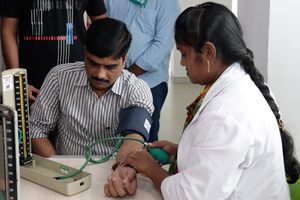
Amaravati, August 24th 2019: SRM University, AP – Amaravati celebrated Founder’s Day by organizing a blood donation camp. More than 120 college students and faculty have donated blood in the camp of which several were first time donors.
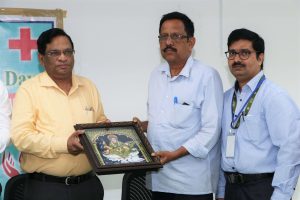 On this occasion, Prof. D. Narayana Rao, Pro Vice Chancellor, SRM University, AP-Amaravati presided over the program and shared the Founder and Chancellor, Hon’ble Member of Parliament, Dr. T.R. Paarivendhar’s vision and generous contributions to the society through various social services activities. “21 educational institutions have been established by SRM management under the leadership of Dr. Paarivendhar and till date around 1.10 lakhs students have passed out from different educational streams. Our Founder’s vision is to provide education to all and has therefore provided scholarships to the tune of Rs. 35 crore till date to the underprivileged sections of the society. The SRM institutions have more than 7,000 employees and 70,000 students currently.” shared Prof. Rao.
On this occasion, Prof. D. Narayana Rao, Pro Vice Chancellor, SRM University, AP-Amaravati presided over the program and shared the Founder and Chancellor, Hon’ble Member of Parliament, Dr. T.R. Paarivendhar’s vision and generous contributions to the society through various social services activities. “21 educational institutions have been established by SRM management under the leadership of Dr. Paarivendhar and till date around 1.10 lakhs students have passed out from different educational streams. Our Founder’s vision is to provide education to all and has therefore provided scholarships to the tune of Rs. 35 crore till date to the underprivileged sections of the society. The SRM institutions have more than 7,000 employees and 70,000 students currently.” shared Prof. Rao.
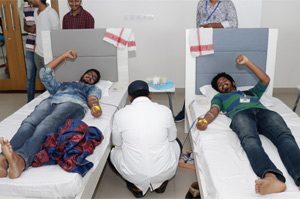 The University’s NSS division organised a blood donation camp together with the international Red Cross society. This was in line with the Founder’s vision to serve the community.
The University’s NSS division organised a blood donation camp together with the international Red Cross society. This was in line with the Founder’s vision to serve the community.
“SRM Management is spending generously for the welfare of the underprivileged people.”, commented, D. Gunasekaran, Registrar, SRM University, AP – Amaravati. The Registrar also motivated and thanked the students by emphasising that blood donation is a big contribution towards the welfare of the society.
Dr. Lakshmi Rajyam, University Medical Officer, SRM University AP-Amaravati encouraged the students and staff to donate blood and explained, “A healthy body is capable of regenerating the blood donated in a few weeks’ time. India needs about 5 crore units of blood annually but has only 2.5 crore units available. This deficit can only be bridged if everyone comes forward to donate.”
Present for this celebration were – ProVC, Registrar, Deputy Registrar, University Medical Officer – Dr. Lakshmi Rajyam and Red Cross Guntur District incharge, Mr. Narasimha Rao along with faculty and students.
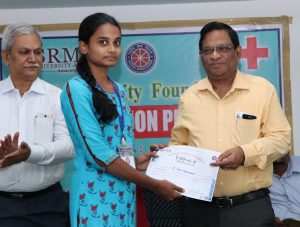 At this occasion, 20 NSS students were awarded certificates for their remarkable contributions to the community. The University got together and cut a cake to mark Founder’s Day.
At this occasion, 20 NSS students were awarded certificates for their remarkable contributions to the community. The University got together and cut a cake to mark Founder’s Day.
Video Link: https://www.youtube.com/embed/ZHih6PGfI-0
- Published in Events


